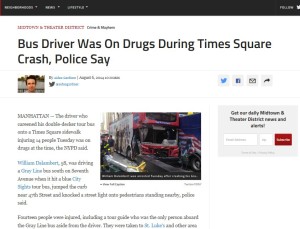DOT Supervisor Training Online
DOT Compliance
The Department of Transportation (DOT) requires federally regulated company’s employees, supervisor or otherwise, who have the ability to make a reasonable suspicion test determination be trained on 60 minutes drug and 60 minutes alcohol signs and symptoms of use and abuse. Common ways to fulfill this requirement are by video, powerpoint, in-person, or online. Each method has its benefits however training videos are generally very outdated (think 1980’s with horrible actors) and in-person training can be expensive and difficult to coordinate schedules. Online training also works well for training new supervisor’s quickly so there are no gaps between when they are trained and when they might have to make their first reasonable suspicion determination.
Record Keeping
Part of the DOT regulations state that employers are required to keep training records on hand indefinitely. One great feature of AtHandTraining’s DOT supervisor training online course is that the system automatically maintains records the training records and generates a certificate of completion for the trainee.
Recurring Training?
Most supervisors only need to complete training one-time during their employ, however the DOT would recommend that supervisors repeat the training couse every two years as best practice. FAA covered supervisors will need to repeat training every 12-18 months.
What is Reasonable Suspicion or “for cause” Drug Testing?
A DOT reasonable suspicion drug test is required when trained observer(s) believes the behaviors (physical, behavioral, mental) could reasonably be the result of the individual’s use or abuse of controlled/banned substances or if the supervisor has actual knowledge the employee has used alcohol during banned periods or controlled substances. Observations must be based on specific, contemporaneous, articulable observations concerning the appearance, behavior, speech or body odors.
For drugs, an employee would be in violation of DOT regulations if prohibited substances are detected in their system without a valid prescription or explanation – even if they are not currently impaired. This means that if an employee smoked weed during a two-week vacation they could test positive weeks after use. Alcohol testing however, tests for current impairment.
Workplace Safety
Although it’s important to ensure employees who can make reasonable suspicion/cause determinations are trained so you can be in compliance, the underlying reason to ensure your staff are trained is to maintain a safe and secure workplace environment and ensure the safety of the general public. Every year there are reports of crashes or injuries resulting from drug or alcohol abuse related to the transportation industry. Happily, drug and alcohol abuse rates are lower in transit industries than they are in the general populations but that is likely a result of mandatory, and well-run drug and alcohol testing programs. Since supervisors are the first line of defense in the prevention of these types of accidents it’s crucial they receive the required training.
Know and Communicate Your Policy
The DOT can change regulations from time to time and supervisors might be observing non-DOT employees under your general drug free workplace program. Therefore it’s imperitive that those who can make reasonable suspicion determinations fully understand both the DOT regualtions and your companies general drug free workplace policy. Prohibited employee conduct regarding drug and alcohol use should be clearly defined and communicated to all employees. It can be helpful to ensure the employees are also trained and have a good background knowledge of the substance abuse testing process and what’s expected of them.
DOT Regulations
Federal Motor Carrier Safety Administration (FMCSA) – 49CFR Part 382.603
§ 382.603: Training for supervisors. Each employer shall ensure that all persons designated to supervise drivers receive at least 60 minutes of training on alcohol misuse and receive at least an additional 60 minutes of training on controlled substances use. The training will be used by the supervisors to determine whether reasonable suspicion exists to require a driver to undergo testing under § 382.307. The training shall include the physical, behavioral, speech, and performance indicators of probable alcohol misuse and use of controlled substances. Recurrent training for supervisory personnel is not required.
Federal Aviation Administration (FAA) – 14 CFR Part 121 Append I & J
Drug Testing: Testing Based on Reasonable Cause. Each employer must test each employee who performs a safety-sensitive function and who is reasonably suspected of having used a prohibited drug. The decision to test must be based on a reasonable and articulable belief that the employee is using a prohibited drug on the basis of specific contemporaneous physical, behavioral, or performance indicators of probable drug use. At least two of the employee’s supervisors, one of whom is trained in detection of the symptoms of possible drug use, must substantiate and concur in the decision to test an employee who is reasonably suspected of drug use; except that in the case of an employer, other than a part 121 certificate holder, who employs 50 or fewer employees who perform safety-sensitive functions, one supervisor who is trained in detection of symptoms of possible drug use must substantiate the decision to test an employee who is reasonably suspected of drug use.
Alcohol Reasonable Suspicion Testing: 2. The employer’s determination that reasonable suspicion exists to require the covered employee to undergo an alcohol test shall be based on specific, contemporaneous, articulable observations concerning the appearance, behavior, speech or body odors of the employee. The required observations shall be made by a supervisor who is trained in detecting the symptoms of alcohol misuse. The supervisor who makes the determination that reasonable suspicion exists shall not conduct the breath alcohol test on that employee.
Federal Transit Administration (FTA) – 49 CFR 655
655.14 Education and training programs.
Each employer shall establish an employee education and training program for all covered employees, including:
(a) Education. The education component shall include display and distribution to every covered employee of: informational material and a community service hot-line telephone number for employee assistance, if available. (b) Training—(1) Covered employees. Covered employees must receive at least 60 minutes of training on the effects and consequences of prohibited drug use on personal health, safety, and the work environment, and on the signs and symptoms that may indicate prohibited drug use. (2) Supervisors. Supervisors and/or other company officers authorized by the employer to make reasonable suspicion determinations shall receive at least 60 minutes of training on the physical, behavioral, and performance indicators of probable drug use and at least 60 minutes of training on the physical, behavioral, speech, and performance indicators of probable alcohol misuse.
Pipeline and Hazardous Materials Safety administration (PHMSA)
Drug Testing: (d) Testing based on reasonable cause. Each operator shall drug test each employee when there is reasonable cause to believe the employee is using a prohibited drug. The decision to test must be based on a reasonable and articulable belief that the employee is using a prohibited drug on the basis of specific, contemporaneous physical, behavioral, or performance indicators of probable drug use. At least two of the employee’s supervisors, one of whom is trained in detection of the possible symptoms of drug use, shall substantiate and concur in the decision to test an employee. The concurrence between the two supervisors may be by telephone. However, in the case of operators with 50 or fewer employees subject to testing under this part, only one supervisor of the employee trained in detecting possible drug use symptoms shall substantiate the decision to test.
Alcohol Testing: §199.241 Training for supervisors. Each operator shall ensure that persons designated to determine whether reasonable suspicion exists to require a covered employee to undergo alcohol testing under §199.225(b) receive at least 60 minutes of training on the physical, behavioral, speech, and performance indicators of probable alcohol misuse.
U.S. Coast Guard (USCG) – §16.250 Reasonable cause testing requirements
(a) The marine employer shall require any crewmember engaged or employed on board a vessel owned in the United States that is required by law or regulation to engage, employ or be operated by an individual holding a credential issued under this subchapter, who is reasonably suspected of using a dangerous drug to be chemically tested for dangerous drugs.
(b) The marine employer’s decision to test must be based on a reasonable and articulable belief that the individual has used a dangerous drug based on direct observation of specific, contemporaneous physical, behavioral, or performance indicators of probable use. Where practicable, this belief should be based on the observation of the individual by two persons in supervisory positions.
Supervisors must be given at least sixty minutes of training.
Federal Railroad Administration (FRA) – §219.300 Mandatory reasonable suspicion testing. *
(a) Requirements. (1) A railroad must require a covered employee to submit to an alcohol test when the railroad has reasonable suspicion to believe that the employee has violated any prohibition of subpart B of this part concerning use of alcohol. The railroad’s determination that reasonable suspicion exists to require the covered employee to undergo an alcohol test must be based on specific, contemporaneous, articulable observations concerning the appearance, behavior, speech or body odors of the employee.
(2) A railroad must require a covered employee to submit to a drug test when the railroad has reasonable suspicion to believe that the employee has violated the prohibitions of subpart B of this part concerning use of controlled substances. The railroad’s determination that reasonable suspicion exists to require the covered employee to undergo a drug test must be based on specific, contemporaneous, articulable observations concerning the appearance, behavior, speech or body odors of the employee. Such observations may include indications of the chronic and withdrawal effects of drugs.
(b)(1) With respect to an alcohol test, the required observations must be made by a supervisor trained in accordance with §219.11(g). The supervisor who makes the determination that reasonable suspicion exists may not conduct testing on that employee.
(2) With respect to a drug test, the required observations must be made by two supervisors, at least one of whom is trained in accordance with §219.11(g).
* Note: AtHandTraining’s DOT supervisor training course does not fulfill the 3-hour FRA requirement.
![]()
- Full 2 hour course only $35!
- DOT Compliant for any 60/60 min. DOT supervisor training for reasonable suspicion signs and symptoms. FMCSA = Yes | FAA = Yes | FTA = Yes | PHMSA = Yes | USCG = Yes
- Company administrator can access all employee records
- Use any mobile device, iPad or PC with any browser. Go ahead, be crazy – start on one device, finish on another!
Course topics
Intro: The Drug Free Workplace Act of 1988 | Reasonable suspicion training requirements (Regulations overview) | Record keeping | Course learning objectives
The Big Picture: The effects of substance abuse on society | The effects of substance abuse on the individual and family | The effects of substance abuse in the workplace
Drug Testing: The drug testing process & safeguards | Substance Abuse Professionals | DOT substance testing | Detection times | Refusals
Alcohol Testing: The alcohol testing process | Evidential breath tests (EBTs) | Breath Alcohol content (BAC)
Drug Classifications & Effects of Use: Depressants | Stimulants | Hallucinogens | Other drugs of abuse (K2/Spice, Bath Salts, etc.)
The Supervisors Role: Role overview | Confidentiality | Reasonable suspicion testing | Specific, Contemporaneous, articulable definitions w/examples
Common Use Indicators: Identifying abusers | Stereotyping | Physical symptoms | Behavioral symptoms | Mental symptoms | Job performance | Drug paraphernalia
Intervention: Crisis vs. performance scenarios | Documentation | Enabling | Confrontation and interview | Dos and don’ts | Transportation to the collection site
Sample screenshots
Resources:
Download a free DOT Reasonable Suspicion Checklist here



